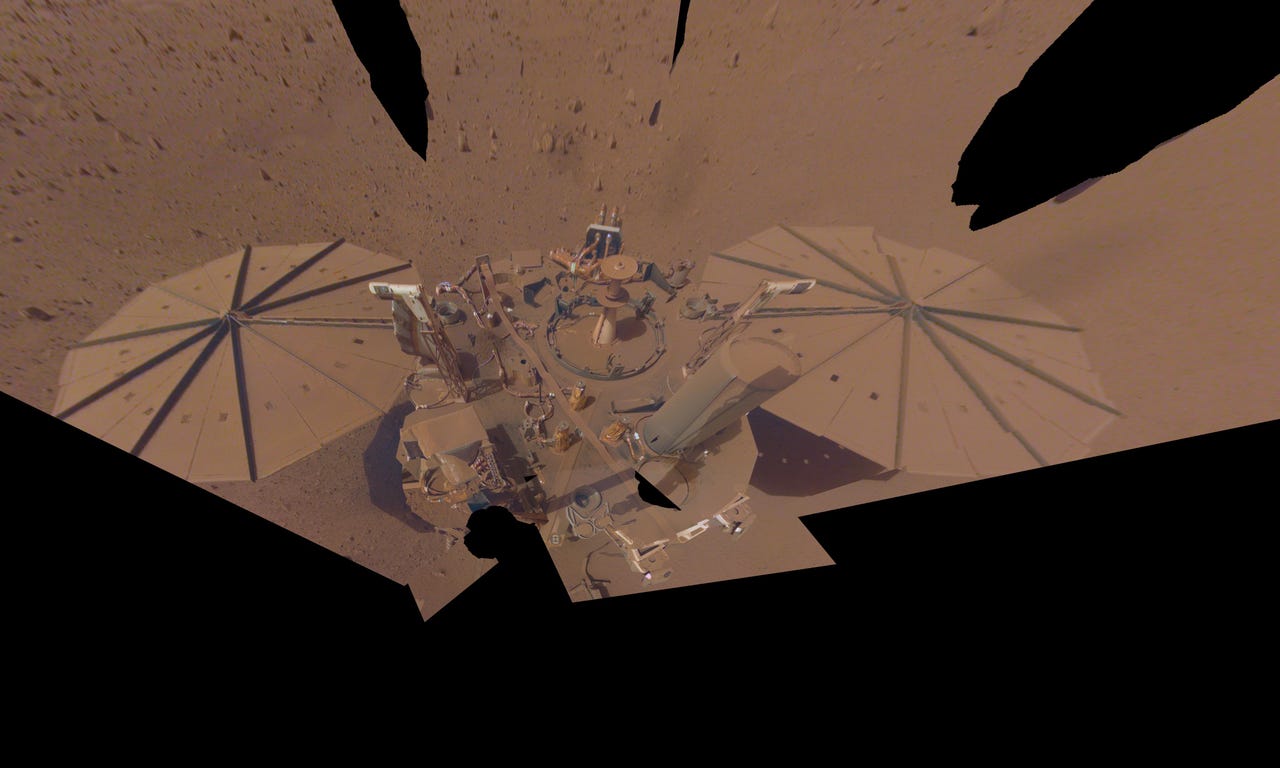
































InSight's Final Selfie.
Image: NASA/JPL-CaltechNASA's InSight Mars lander has sent back its last selfie of its dust-covered solar panels and deck, in an image taken on its 1,211th 'sol' or Martian day of the mission on April 24.
InSight has been roaming the red planet for the past 3.5 years, capturing images and data that allowed scientists to approximate its crust and core, and refine models of how planets evolved from dust circling the Sun.
InSight's scientific mission is set to conclude in summer after which it will run out of power. The lander is solar-powered, but dust covering the seven-feet wide solar panels has reduced its production capacity from around 5,000 watt-hours per sol to 500 watt-hours per sol. Once these panels generated power equivalent to running an electric oven for 40 minutes, they now can only power one for 10 minutes. The lander is equipped with two 25 amp-hour lithium-ion rechargeable batteries for energy storage.
SEE:NASA's Mars helicopter just took these remarkable photos of the rover's landing gear
With those constraints, even taking a selfie requires some calculation to stay within the spacecraft's power budget. The selfie arm will now go into the "retirement pose", according to NASA.
"The arm needs to move several times in order to capture a full selfie. Because InSight's dusty solar panels are producing less power, the team will soon put the lander's robotic arm in its resting position (called the "retirement pose") for the last time in May of 2022," NASA JPL said.
InSight launched from Vandenberg Air Force Base in California on May 5, 2018 and landed on Mars on November 26, 2018, six minutes after hitting the the Martian atmosphere at 12,300 mph (19,800 kilometers per hour), according to NASA. It was the eighth landing on Mars in human history.
Dust has played a significant role in the InSight lander's capability to continue the mission. An epic dust storm on Mars in 2018 is believed to have been behind the demise of NASA's Opportunity rover. A similar storm could have threatened InSight's mission, too. The threat from dust is two-fold: dust storms obscure available sunlight, while dust directly on the solar panels reduce their capacity to absorb sunlight.
In September, 2021, on its 1,000th sol of the mission, InSight measured a "marsquake" with a magnitude of 4.2, which helped scientists see what's happening beneath Mars' surface.
Located on the dark side of Mars at the time, dust on the solar panels was already restricting their power output. NASA used Insight's robotic arm to sprinkle sand near one solar panel, hoping wind gusts would make the granules sweep off some of the dust. The plan worked.
SEE:NASA's Mars lander is running out of power. Here's what happens next
Then on January 7, 2022, InSight went into safe mode after a major dust storm obscured sunlight from its solar panels. But by that stage, performing the 'sand sweep' technique had become difficult because of reduced available energy. InSight's engineers were hoping a whirlwind would clear dust from the panels and had restricted the use of science instruments. By February 15, the solar panels' output levels had returned to pre-storm levels.
InSight's onboard computers for command and data handling are derived from NASA's 2014 Mars Atmosphere and Volatile Evolution (MAVEN) and its 2011 Moon Gravity Recovery and Interior Laboratory (GRAIL) missions. The system has two redundant computers. Its core is a radiation-hardened 115.5 MHz CPU with a PowerPC 750 architecture called RAD 750 that was made by BAE Systems.
Its flight software is written in C and C++ on the VxWorks real-time operating system, which monitors the spacecraft's health, checks for commands to execute, and handles communications and controls. It also checks commands for faults and handles corrective steps when it detects irregularities.
An animation of the last selfie.
Image: NASA/JPL-Caltech Tags quentes :
Inovação
Espaço
Tags quentes :
Inovação
Espaço